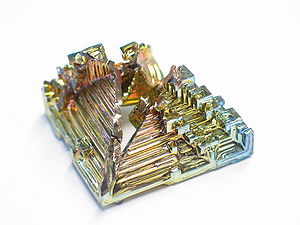
Hopper crystal
Encyclopedia

Crystal
A crystal or crystalline solid is a solid material whose constituent atoms, molecules, or ions are arranged in an orderly repeating pattern extending in all three spatial dimensions. The scientific study of crystals and crystal formation is known as crystallography...
, defined by its "hopper
Gravity wagon
The Gravity wagon, or Slant wagon, is an angled hopper style wagon that utilizes gravity to make the unloading process easier. It is primarily used for on farms for agricultural purposes, such as for holding crops or fertilizer...
ed" shape.
The edges of hoppered crystals are fully developed, but the interior spaces are not filled in. This results in what appears to be a hollowed out step lattice formation, as if someone had removed interior sections of the individual crystals. In fact, the "removed" sections never filled in, because the crystal was growing so rapidly that there was not enough time (or material) to fill in the gaps. The interior edges of a hoppered crystal still show the crystal form characteristic to the specific mineral
Mineral
A mineral is a naturally occurring solid chemical substance formed through biogeochemical processes, having characteristic chemical composition, highly ordered atomic structure, and specific physical properties. By comparison, a rock is an aggregate of minerals and/or mineraloids and does not...
, and so appear to be a series of smaller and smaller stepped down miniature versions of the original crystal.
Hoppering occurs when the anisotropy of the solid–liquid inter-facial energy and the kinetics of atom attachment at the interface are both important. For example, when electrical attraction
Electricity
Electricity is a general term encompassing a variety of phenomena resulting from the presence and flow of electric charge. These include many easily recognizable phenomena, such as lightning, static electricity, and the flow of electrical current in an electrical wire...
is higher along the edges of the crystal, this causes faster growth at the edges than near the face centers. This attraction draws the mineral molecule
Molecule
A molecule is an electrically neutral group of at least two atoms held together by covalent chemical bonds. Molecules are distinguished from ions by their electrical charge...
s more strongly than the interior sections of the crystal, thus the edges develop more quickly. However, the basic physics of the this type of growth is the same as that of dendrites but, because the anisotropy in the solid–liquid inter-facial energy is so large, the dendrite so produced exhibits a faceted morphology.
Hoppering is common in many minerals, including lab-grown bismuth
Bismuth
Bismuth is a chemical element with symbol Bi and atomic number 83. Bismuth, a trivalent poor metal, chemically resembles arsenic and antimony. Elemental bismuth may occur naturally uncombined, although its sulfide and oxide form important commercial ores. The free element is 86% as dense as lead...
, galena
Galena
Galena is the natural mineral form of lead sulfide. It is the most important lead ore mineral.Galena is one of the most abundant and widely distributed sulfide minerals. It crystallizes in the cubic crystal system often showing octahedral forms...
, quartz
Quartz
Quartz is the second-most-abundant mineral in the Earth's continental crust, after feldspar. It is made up of a continuous framework of SiO4 silicon–oxygen tetrahedra, with each oxygen being shared between two tetrahedra, giving an overall formula SiO2. There are many different varieties of quartz,...
(called skeletal or fenster crystals), gold
Gold
Gold is a chemical element with the symbol Au and an atomic number of 79. Gold is a dense, soft, shiny, malleable and ductile metal. Pure gold has a bright yellow color and luster traditionally considered attractive, which it maintains without oxidizing in air or water. Chemically, gold is a...
, calcite
Calcite
Calcite is a carbonate mineral and the most stable polymorph of calcium carbonate . The other polymorphs are the minerals aragonite and vaterite. Aragonite will change to calcite at 380-470°C, and vaterite is even less stable.-Properties:...
, halite
Halite
Halite , commonly known as rock salt, is the mineral form of sodium chloride . Halite forms isometric crystals. The mineral is typically colorless or white, but may also be light blue, dark blue, purple, pink, red, orange, yellow or gray depending on the amount and type of impurities...
(salt), and water
Water
Water is a chemical substance with the chemical formula H2O. A water molecule contains one oxygen and two hydrogen atoms connected by covalent bonds. Water is a liquid at ambient conditions, but it often co-exists on Earth with its solid state, ice, and gaseous state . Water also exists in a...
(ice).

